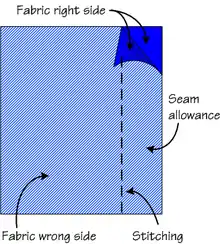Seam allowance
Seam allowance (sometimes called inlays) is the area between the fabric edge and the stitching line on two (or more) pieces of material being sewn together. Seam allowances can range from 1⁄4 inch (6.4 mm) wide to as much as several inches.[1] Commercial patterns for home sewers have seam allowances ranging from 1⁄4 to 5⁄8 inch (6.4 to 15.9 mm).[2]

Sewing industry seam allowances range from 1⁄4 inch (6.4 mm) for curved areas (e.g. neck line, armscye) or hidden seams (e.g. facing seams), to 1 inch (25 mm) or more for areas that require extra fabric for final fitting to the wearer (e.g. center back). Curved seams generally have a smaller seam allowance than straight seams; bulky seams with a large amount of seam allowance are more difficult to press into or conform to a curved shape.[1]
References
- Kim, Myoungok; Kim, Injoo (2014). Patternmaking for Menswear: Classic to Contemporary. New York, NY: Bloomsburg Publishing Inc. p. 57. ISBN 160901944X.
- Matthews-Fairbanks, Jennifer Lynne (2018). "Pattern Basics". Pattern Design Fundamentals: Construction and Pattern Drafting for Fashion Design. Fairbanks Publishing, LLC. p. 24. ISBN 1725927721.